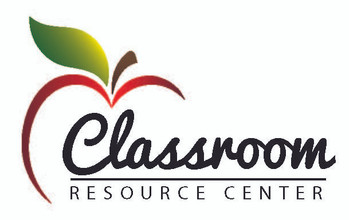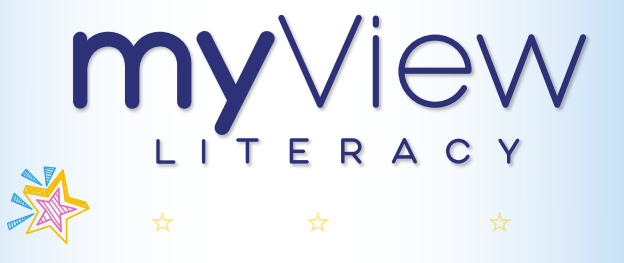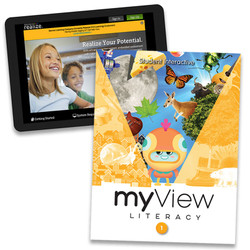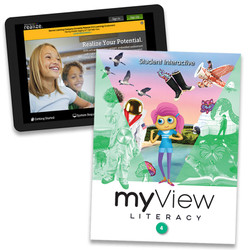My View Literacy Grade 3 Bundle
MyView Literacy 3 is a comprehensive, interactive literacy program that provides a balanced approach to teaching reading, writing, speaking, listening and viewing using a collection of authentic reading texts and writing workshops.
Features of My View Literacy Third Grade
- Each bundle includes a Student edition and 1-year student and teacher digital access to SavvasRealize.com.
- Connected Reading and Writing Workshops focus on teaching the critical skills and strategies students need to be highly competent thinkers, readers, and writers ready for college and career.
- Focus on developing foundational skills and comprehension strategies to ensure that students are equipped to learn to read.
- Time-saving lesson plans and all-in-one resources.
- Create opportunities for student success.
- Encourage students to become independent learners.
Each myView Literacy 3 Kit includes:
- myView Literacy 2020 Student Interactive Grade 3 Volume 1 ISBN-13: 9780134908823
- myView Literacy 2020 Student Interactive Grade 3 Volume 2 ISBN-13: 9780134908830
- Digital Access Card ISBN-13: 9780328972609
Digital components come with a 1-year online subscription.
**NOTE: The Digital Access Card comes in your print package. Please locate it as soon as you open your package(s). It has the instructions you need to access your online digital content on the Savvas Realize™ Digital Platform. Your Order Number is needed when you apply for access. It is located on the label on the box. - myView Literacy 2020 Digital Courseware 1-year License for grade 3 ISBN-13: 9780134972282

The myView Literacy courses are well-crafted and packed with interesting reading selections, and panoramic in their inclusion of language arts skills.
Organizationally, there are five units in each course. Units are each covered over a six-week time frame. A Reading Workshop, a Writing Workshop, and a Reading-Writing Bridge are packed into each week. Units conclude with a week-long Project-Based Inquiry or, in other words, a grade-appropriate research project. Throughout the Unit, thought-provoking, world-expanding themes and language arts skills are woven together. This course can be completed thoroughly using just the worktexts. Nevertheless, there are elements available through the companion SavvasRealize online platform that add sparkle and usefulness. The online components are quite helpful, for they alone contain the answers to text exercises and tests.
The Teacher Guide – an ebook – provides detailed lesson plans, schedules, and pacing. This is a wraparound book so all student pages are present with answers. Teacher-student interaction is a foundational part of the courses. An involved teacher who is reading through student material ( you’ll find it interesting), and interacting daily with their student might not need these text answers for the lower levels, but answers/tests do provide a safety-net and efficiency and are more necessary at the upper levels. Online test-taking is easy. Students have the option of playing a recording of the questions or reading them – or both. Most are multiple choice but writing activities are included. Answers are corrected and students can look at missed answers. The Savvas platform also provides a good quantity of additional teacher helps and printable material.
The “sparkle” are things like audio book readings of the literature selections, reinforcement games, flashcards, and videos. The SavvasRealize online platform is relatively easy to navigate.
The Student Worktexts are appealing and engaging. They walk through the lessons with embedded reading selections, instructional text, questions, exercises, and sidebar content (in upper levels). The various unit/lesson parts are color-coded and icon identified.
Reading Workshops provide the stalwart core of this program. Across the grade levels they provide background information, an anchor chart, vocabulary, the actual reading selection, comprehension checks, close read activities, and response to text (reflect and share). In the early grades there is a focus on “foundational skills” – i.e. phonological awareness, phonics, decoding, and fluency. In the upper grades there is more emphasis on literary analysis and thinking skills.
In each lesson, the Reading Workshops material ends with a “Response to the Text” activity. This is a lead into the Reading-Writing Bridge portion of the week’s lesson. Here you will find coverage on word study, spelling, language/conventions (a.k.a. grammar, usage, and mechanics), and a section called “Read Like a Writer; Write for a Reader” that provides exercises designed to analyze, duplicate, and incorporate the traits of accomplished authors.
The remaining portion of the weekly lesson sequence is the Writing Workshop. While primarily covering the various parts of the writing process (i.e. brainstorming, rough draft writing, editing, and publishing) they will also cover a diverse range of related topics. For instance, using digital tools such as bolding, graphics/illustrations, and research.
Literary genres included in these courses are broad and diverse. You will find folktales and myths more likely in the early grades and argumentative text at the upper grades, but in general, the genres include: fiction (all types – realistic, historical, science), legend, drama, poetry, informational text, biography, persuasive text, and narrative nonfiction. The various grade-level collections are impressive and rather stunning in their scope. Intriguing and you may find yourself learning new things.
Starting right out in the Kindergarten course, one week in each unit is devoted to Project-Based Inquiry. These are setting the groundwork for the upper-level Inquiry weeks that are full-blown research projects. So, for example, Kindergartners are asked to think through their own preferences on a topic, gather information from a partner, and develop a three-line-item research plan as well as to research (find a related poem and explore a kid-based search engine). Concluding the unit, they are asked to write (or draw) content that reflects their research and opinions. While this all sounds rather rigorous for kindergartners, the material and steps as presented seem very grade-appropriate and doable.
At the other end of the grade spectrum in this series, the research “steps” are essentially the same but the expectations are much more sophisticated. Using academic words, evaluating sources, taking notes, and writing an essay with primary/secondary sources have all been added into the basic research outline. Again, though, students have been well prepared and have a strong foundation (built within the year and through the courses) for what they are being asked to do.
These courses are designed to be teacher-student interactive. As such, they will definitely require a time commitment from the teacher (probably 20-40 minutes a day – the high end for older students). The worktexts, though, are written directly to the student with the idea that the teacher/parent is looking over their shoulder. All materials are user-friendly including the online ones. Teacher prep is mainly relegated to determining what, if any, online material to incorporate. But the worktexts may be used by themselves. Because many activities have variable answers the online answer key is not alwasy necessary. Extra practice worksheets are available if and when needed.
With these excellent, comprehensive, standards-based, and affordable language arts courses Pearson/Savvas Learning has supplied the homeschool community with a treasure. These courses provide complete language arts: phonics, reading skills, literature skills, vocabulary, spelling, grammar, usage, mechanics, handwriting practice, composition skills and even speech experiences. Some might want to add systematic spelling and/or handwriting.









